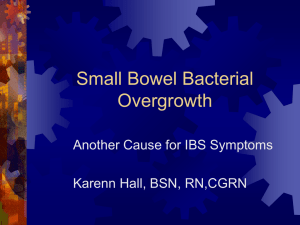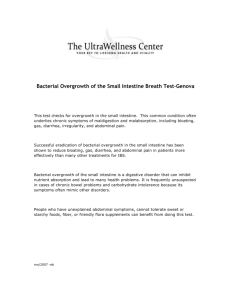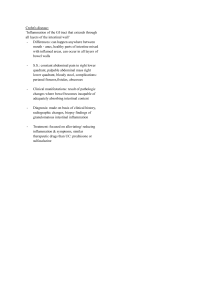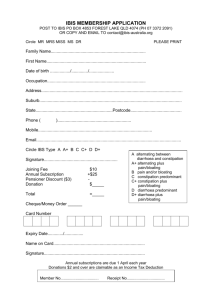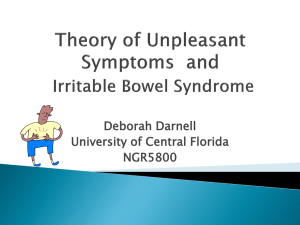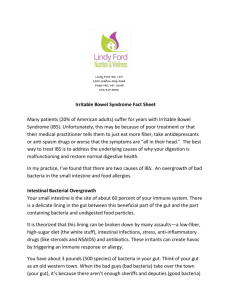Gas and Bloating: Causes, Diagnosis, and Treatment
advertisement
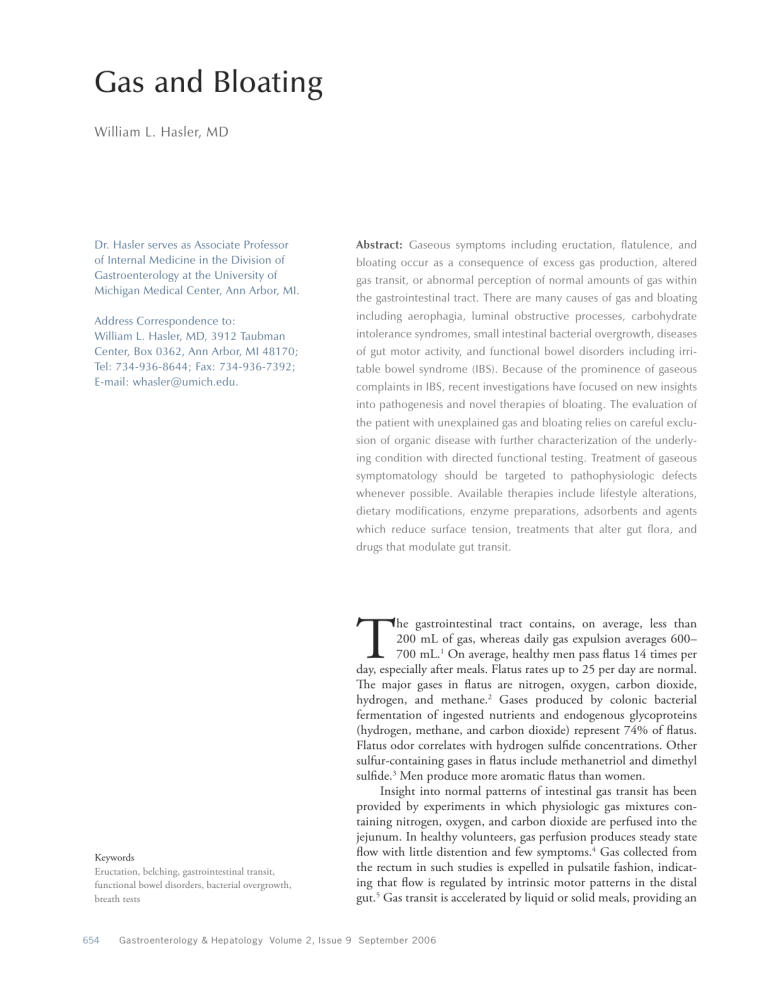
Gas and Bloating William L. Hasler, MD Dr. Hasler serves as Associate Professor of Internal Medicine in the Division of Gastroenterology at the University of Michigan Medical Center, Ann Arbor, MI. Abstract: Gaseous symptoms including eructation, flatulence, and Address Correspondence to: William L. Hasler, MD, 3912 Taubman Center, Box 0362, Ann Arbor, MI 48170; Tel: 734-936-8644; Fax: 734-936-7392; E-mail: whasler@umich.edu. including aerophagia, luminal obstructive processes, carbohydrate bloating occur as a consequence of excess gas production, altered gas transit, or abnormal perception of normal amounts of gas within the gastrointestinal tract. There are many causes of gas and bloating intolerance syndromes, small intestinal bacterial overgrowth, diseases of gut motor activity, and functional bowel disorders including irritable bowel syndrome (IBS). Because of the prominence of gaseous complaints in IBS, recent investigations have focused on new insights into pathogenesis and novel therapies of bloating. The evaluation of the patient with unexplained gas and bloating relies on careful exclusion of organic disease with further characterization of the underlying condition with directed functional testing. Treatment of gaseous symptomatology should be targeted to pathophysiologic defects whenever possible. Available therapies include lifestyle alterations, dietary modifications, enzyme preparations, adsorbents and agents which reduce surface tension, treatments that alter gut flora, and drugs that modulate gut transit. T Keywords Eructation, belching, gastrointestinal transit, functional bowel disorders, bacterial overgrowth, breath tests 654 he gastrointestinal tract contains, on average, less than 200 mL of gas, whereas daily gas expulsion averages 600– 700 mL.1 On average, healthy men pass flatus 14 times per day, especially after meals. Flatus rates up to 25 per day are normal. The major gases in flatus are nitrogen, oxygen, carbon dioxide, hydrogen, and methane.2 Gases produced by colonic bacterial fermentation of ingested nutrients and endogenous glycoproteins (hydrogen, methane, and carbon dioxide) represent 74% of flatus. Flatus odor correlates with hydrogen sulfide concentrations. Other sulfur-containing gases in flatus include methanetriol and dimethyl sulfide.3 Men produce more aromatic flatus than women. Insight into normal patterns of intestinal gas transit has been provided by experiments in which physiologic gas mixtures containing nitrogen, oxygen, and carbon dioxide are perfused into the jejunum. In healthy volunteers, gas perfusion produces steady state flow with little distention and few symptoms.4 Gas collected from the rectum in such studies is expelled in pulsatile fashion, indicating that flow is regulated by intrinsic motor patterns in the distal gut.5 Gas transit is accelerated by liquid or solid meals, providing an Gastroenterology & Hepatology Volume 2, Issue 9 September 2006 G A S A N D B L O AT I N G Table 1. Differential Diagnosis of Gas and Bloating Mechanical Obstruction • • • • • Gastric outlet obstruction Small intestinal obstruction Superior mesenteric artery syndrome Colonic obstruction Volvulus Carbohydrate Intolerance • Lactase deficiency • Intolerance of poorly absorbed sugars (eg, fructose, sorbitol) • Hereditary disorders (eg, sucrase-isomaltase deficiency) • Intolerance of complex carbohydrates and fiber • Secondary causes of carbohydrate intolerance (eg, celiac disease) Small Intestinal Bacterial Overgrowth • • • • • • • Small intestinal stasis Hypochlorhydria Immunodeficiency Coloenteric fistula Coprophagia Elderly patients Irritable bowel syndrome Gastroparesis Rapid gastric emptying Gas-bloat syndrome after fundoplication Chronic intestinal pseudo-obstruction Slow transit constipation Acute adynamic ileus Acute colonic pseudo-obstruction Gas and bloating are consequences of several disorders (Table 1). Symptoms result from excess gas production, altered gas transit, or abnormal perception of normal amounts of gas within the gut. Carbohydrate Maldigestion Maldigestion and malabsorption of simple and complex carbohydrates and dietary fiber are commonly associated with gas and bloating. Unabsorbed carbohydrates are propelled to the colon and serve as nutrient substrates for enteric bacteria, liberating hydrogen gas and short-chain fatty acids. Carbohydrate intolerance results from loss of enterocyte enzymes in normal intestinal mucosa, inability to transport a poorly absorbed sugar across normal enterocyte membranes, or organic mucosal disorders such as celiac disease. Functional Bowel Disorders • Irritable bowel syndrome • Functional dyspepsia • Functional bloating Miscellaneous Causes • • • • • Pathogenesis of Gas and Bloating Mechanical Obstruction Several organic conditions produce bloating by mechanically inhibiting gas transit in the gastrointestinal tract. Pyloric obstruction may result from ulcer-induced stricture or neoplasm in adults or from idiopathic stenosis in infants. Small intestinal obstruction most commonly is a consequence of adhesions, but also occurs with inflammation, radiation-induced stricture, or malignancy. Bloating from colonic obstruction occurs less frequently and most often results from carcinoma. Dysmotility Syndromes • • • • • • • of eructation show decreased lower esophageal sphincter tone followed by upper esophageal sphincter relaxation.7 Flatulence is the volitional or involuntary release of gas from the anus. Manometric studies during flatulence demonstrate propagated colon contractions with increased rectal pressure and early anal relaxation.8 Bloating is the perception of retained gas and is experienced monthly by 15.9% of the population.9 Bloating is more common in women (19.2%) than men (10.5%). Other symptoms experienced by patients with gaseous complaints include abdominal pain, halitosis, anorexia, early satiety, nausea, loud borborygmi, and bowel dysfunction. Aerophagia Magenblase syndrome Medications Endocrine disorders (eg, hypothyroidism) Inferior myocardial infarction experimental correlate to the observation that gas passage and gaseous symptoms increase postprandially.6 Clinical Syndromes Luminal gas is responsible for several phenomena. Eructation, or belching, is the retrograde expulsion of gas from the mouth. The Magenblase syndrome is defined as fullness and bloating relieved by belching. Manometric studies Intolerance of Simple Sugars The most common carbohydrate maldigestion syndrome, lactose intolerance, results from insufficient levels of enterocyte lactase, which hydrolyzes lactose into glucose and galactose. Lactase deficiency occurs in 21% of nonhispanic whites but is more prevalent in those of African (75%), Hispanic (51%), and Native American (79%) background.10 Individuals with lactose intolerance rarely experience symptoms unless more than 240 mL of milk are ingested per day.11 Impaired assimilation of other simple sugars produces gaseous symptoms as well. Forty percent of fructose is Gastroenterology & Hepatology Volume 2, Issue 9 September 2006 655 HASLER not absorbed in the normal human intestine. Increased gas production occurs after consuming fructose-containing fruits, juices, and soft drinks with a threshold of 37.5 grams of fructose.12 Fructose-intolerant patients pass flatus more frequently and produce more hydrogen for given amounts of fructose versus asymptomatic individuals. Sorbitol, a natural substance in fruits and an artificial sweetener, is malabsorbed by 43% of whites and 55% of nonwhites at doses as low as 5 grams.13 Other potentially malabsorbed carbohydrates include isomalt, xylitol, and (rarely) sucrose. Finally, rare hereditary sugar intolerance syndromes are described. Sucrase-isomaltase deficiency presents with gaseous symptoms after sucrose ingestion, usually in infancy. The disorder is inherited in an autosomal recessive fashion and results from defects in the sucrase-isomaltase gene. Maldigestion of Complex Carbohydrates and Fiber Ingested complex carbohydrates may also be incompletely assimilated. Twenty percent of carbohydrates in baked beans, 7–10% in wheat, oats, potatoes, and corn, and 1% in white rice are malabsorbed.14 Reduced fecal pH levels and increased lactic and volatile fatty acid concentrations demonstrate that most unabsorbed starch is metabolized in the colon. Undigestible oligosaccharides, such as stachyose, raffinose, and verbascose, are abundant in beans and legumes. Flour from soy beans low in these oligosaccharides produces less gas than from standard soybeans.15 Dietary fiber intake correlates with flatus production in many individuals. In one study, fiber-free diets reduced daily gas expulsion from 700 mL to 200 mL.1 However, fecal gas production from incubation with bran produces only 10% as much hydrogen and carbon dioxide as with lactulose, supporting the observations that fiber supplements elicit feelings of bloating but do not increase flatus frequency, whereas lactulose causes elevations in both.16 In a recent study in healthy humans, ingesting 30 grams of psyllium daily retarded transit of a jejunally-perfused gas mixture, providing a possible mechanism for increased gaseous symptoms after fiber supplementation (Table 2).5 Small Intestinal Bacterial Overgrowth Normal jejunal and ileal bacterial counts are 103-4 and 107-9 colony forming units (CFU) per mL, respectively, whereas densities in the colon approach 1012 CFU/mL. Small intestinal bacterial overgrowth is defined by the presence of greater than 105 CFU/mL in proximal intestinal fluid. The main organisms cultured are Streptococcus, Escherichia coli, Lactobacillus, and Bacteroides species. In addition to producing gas, bloating, diarrhea, abdominal discomfort, and nausea, bacterial overgrowth causes nutrient malabsorption, weight loss, and metabolic bone disease. 656 Table 2. Effects of Psyllium on Intestinal Gas Flow Control Diet High Fiber Diet 1,440 ml 1,440 ml Lag time to first gas expulsion 1,129 ± 274 sec 2,265 ± 304 sec* Total gas expelled 1,429 ± 108 ml 1,022 ± 80 ml* Total gas retained 11 ± 108 ml 418 ± 80 ml* Number of gas boluses expelled 20.9 ± 2.5 14.2 ± 1.1* Mean volumes of each bolus 68.2 ± 5.0 70.7 ± 3.4 Total gas perfused over 2 hours * P<.05. Adapted from Gonlachanvit et al.5 The etiologies of bacterial overgrowth are varied. The condition complicates small intestinal obstruction from a variety of causes. Stasis within small intestinal diverticula predisposes to bacterial overgrowth, whereas vagotomy increases intestinal microbial colonization because of hypochlorhydria. Small intestinal bacterial counts are increased by proton pump inhibitors. However, symptoms are not commonly observed.17 Common variable immunodeficiency syndrome may present with bacterial overgrowth from reduced luminal immune surveillance. Forty-three percent of cases of diabetic diarrhea are attributed to bacterial overgrowth, mostly from altered motor function.18 Patients with intestinal pseudo-obstruction develop overgrowth from impaired gut clearance. Cologastric and coloenteric fistulae and coprophagia increase bacterial delivery to the upper gut, overwhelming defenses against infection. Bacterial overgrowth is a recognized cause of gaseous symptoms in the elderly and is likely due to altered motility, acid production, and immune function. Studies employing lactulose breath testing have reported that large subsets (78%) of irritable bowel syndrome (IBS) patients may have bacterial overgrowth as a possible cause of symptoms.19 Subsequent studies have shown transient resolution of symptoms and hydrogen production after antibiotic treatment. However, other groups using other diagnostic methods report much lower rates of overgrowth (10–31%) in IBS and show no response to antibiotics.20,21 This is an area of active investigation. Dysmotility Syndromes Alterations in gut motor function produce gaseous symptoms independent of development of bacterial overgrowth. Bloating and fullness are reported with gastroparesis, intestinal pseudo-obstruction, and chronic constipation from retarded gas transit. Patients with Gastroenterology & Hepatology Volume 2, Issue 9 September 2006 G A S A N D B L O AT I N G rapid gastric emptying complain of fat intolerance and bloating.22 Fundoplication for gastroesophageal reflux reduces the ability to belch or vomit. Gas-bloat syndrome is common in the early postoperative period after fundoplication, especially with preoperative demonstration of gastroparesis, but resolves in 71% of cases.23 Acute adynamic ileus elicits gas and bloating from involvement of the entire gut as does localized dysfunction with acute colonic pseudo-obstruction. Miscellaneous Causes of Gas and Bloating Most upper gut air in healthy individuals results from aerophagia. Aerophagia occurs during negative intrathoracic pressure and is worsened by gum chewing, smoking, or oral irritation. After laryngectomy, air swallowing for esophageal speech may elicit gaseous complaints. Inferior myocardial infarction can lead to excess eructation. Medications (anticholinergics, opiates, calcium blockers, antidepressants) produce gas by effects on gut motility. Functional Bowel Disorders Gaseous symptoms are prevalent in IBS and functional dyspepsia. In one investigation, bloating was rated the most bothersome symptom by 60% of IBS patients, whereas 29% considered pain to be most intrusive.24 Bloating was experienced on 28% of days in another study, whereas pain was reported on 33% of days.25 Constipation-predominant IBS patients experience greater bloating than those with diarrhea. The pathophysiology of gas and bloating in IBS is poorly understood. Early studies referred to a splenic flexure syndrome with localized air-trapping. More recent computed tomography scans of IBS patients show increased lateral abdominal profiles, which may relate to changes in gut muscle tone.26 Others have postulated roles for weak abdominal muscles, a low diaphragm, or exaggerated lumbar lordosis. Increased fermentation and gas generation has been proposed as a cause of bloating in IBS, but studies report variable responses to ingestion or exclusion of carbohydrate substrates. Abnormal gut motor and sensory functions likely participate in generation of bloating in IBS. Ileocolonic transit of radiolabelled bran is accelerated in IBS.27 In argon washout studies, patients with functional abdominal pain retain normal amounts of infused gas although abnormal patterns of transit are observed.28 In jejunal gas perfusion investigations, many IBS patients exhibit abnormal gas retention which correlates with increased distention and symptoms of bloating.29 In a recent study combining gas perfusion with radiolabelled xenon gas transit, patients with bloating exhibited selective retardation of gas flow in the small intestine, suggesting that this region is responsible for gaseous symptoms.30 However, other studies report no alterations in retention and postulate that bloating results from visceral hypersensitivity—a phenomenon which is believed to contribute to pain in IBS.31 Most recently, rectal gas perfusion studies report increases in perception in IBS and functional bloating, which are associated with changes in external and internal oblique muscle contraction, indicating an interaction of visceral and somatic musculature in production of gaseous symptomatology.32 Evaluation of Gas and Bloating The diagnostic approach to the patient with unexplained gas and bloating relies on a careful history and examination complemented by directed structural and functional testing. History and Physical Examination Several historical points must be elicited by the clinician. Relief of symptoms with defecation or flatus is consistent with IBS. Superimposed anxiety or psychiatric disease may associate with aerophagia or IBS. Conversely, vomiting, fever, weight loss, nocturnal diarrhea, rectal bleeding, or steatorrhea indicate probable organic disease. One’s ethnicity and family history increase risks of lactase deficiency or celiac disease. Risk factors for bacterial overgrowth should be assessed. A dietary history should quantify consumption of legumes, unrefined starches, and lactose-, fructose-, or sorbitol-containing foods. The physical examination is usually normal in patients with functional causes of gas and bloating. Abnormal distention with or without altered bowel sounds, occult fecal blood, cutaneous findings (sclerodactyly with scleroderma, dermatitis herpetiformis in celiac disease), peripheral or autonomic neuropathy, cachexia, jaundice, or palpable masses suggest underlying organic disease, which warrants aggressive evaluation. Serious sequelae of gaseous syndromes are rare. Luminal perforation may result from complete intestinal obstruction or acute colonic pseudo-obstruction. Pneumatosis cystoides intestinalis may occur in chronic intestinal pseudo-obstruction from excess small intestinal hydrogen-producing bacteria. Laboratory and Structural Testing Laboratory tests facilitate exclusion of organic disease. In addition to standard hematology and chemistry determinations to screen for inflammatory or mucosal processes, thyroid chemistries or fasting cortisol levels are indicated in some individuals. Serologic testing for celiac disease (tissue transglutaminase or endomysial antibodies) is per- Gastroenterology & Hepatology Volume 2, Issue 9 September 2006 657 HASLER Table 3. Tests of Gut Function in Patients With Gas and Bloating Test Category Tests of Gut Motor Function Breath Testing Flatus Analysis Specific Test Comments Gastric scintigraphy Diagnoses gastroparesis or rapid gastric emptying Octanoate breath test Alternative to scintigraphy to diagnose gastroparesis Small intestinal/colonic scintigraphy Quantifies small intestinal/colonic transit in some academic centers Radioopaque marker colonic transit tests Common test to diagnose slow transit constipation Antroduodenal manometry Facilitates diagnosis of pseudoobstruction; helps distinguish neuropathic versus myopathic etiologies Full thickness intestinal biopsy Definitive test for pseudoobstruction; invasive Lactose hydrogen breath test For lactase deficiency Glucose hydrogen breath test Modest accuracy for diagnosis of small intestinal bacterial overgrowth Lactulose hydrogen breath test Less accurate for diagnosis of small intestinal bacterial overgrowth; used to measure small intestinal transit; may accelerate intestinal transit Fructose/sorbitol hydrogen breath test Uncertain diagnostic utility in patients with functional causes of bloating Breath tests with 14C or 13C labeled substrates Require specialized facilities Flatus quantification and gas chromatography Distinguishes aerophagia from increased gas production formed in patients with appropriate ethnic backgrounds or in those with IBS-like symptoms, due to the increased prevalence of celiac sprue in these populations. Other serologies of value in selected cases include antinuclear antibodies and scleroderma antibodies to evaluate for collagen vascular disease and antinuclear neuronal antibodies to screen for paraneoplastic visceral neuropathy. Stool analysis for Giardia may be indicated in some patients with diarrhea. Imaging tests may be performed to distinguish mechanical obstruction from functional gas retention. Flat and upright abdominal radiographs may show diffuse distention with ileus, haziness in ascites, or air-fluid levels with obstruction. Contrast enema radiography detects distal obstruction, whereas small intestinal contrast studies or CT scanning can characterize partial proximal obstruction. Ultrasound or CT can also further delineate extraluminal processes contributing to gaseous symptoms. Functional Testing When structural tests are negative, methods to quantify gut transit, assess carbohydrate absorption, or measure flatus production can provide insight into the cause of symptoms (Table 3). Tests of Gut Motor Function Gastric emptying tests or gastrointestinal manometry may be performed for suspected gastrointestinal dysmotility. Scintigraphic mea658 sures of emptying of radiolabelled solid meals (99mTc-sulfur colloid in eggs) are employed to exclude gastroparesis or rapid emptying. Other methods of quantifying gastric emptying include isotopic breath tests (eg, 13C-octanoate) and ingested capsule techniques. In some centers, scintigraphy is used to assess rates of small intestinal or colonic transit in suspected pseudo-obstruction and constipation. More often, radio-opaque marker techniques are ordered to diagnose slow transit constipation. In intestinal pseudoobstruction, small intestinal manometry can distinguish neuropathic and myopathic patterns, which may obviate the need for surgical full thickness intestinal biopsy. In some cases, full thickness biopsy may be required to document degeneration of nerve or muscle layers. Breath Testing Hydrogen breath testing can be employed to confirm carbohydrate intolerance as a cause of gaseous symptoms. These methods quantify hydrogen produced by luminal bacteria during metabolism of ingested test substrates. Conversely, carbohydrate metabolism by human tissues does not elicit hydrogen production. Expired breath samples are obtained before and for 2 hours after ingesting a solution of the sugar, which is presumed to be maldigested or malabsorbed. Hydrogen rises of more than 20 parts per million within 120 minutes of lactose ingestion distinguish biopsy-proven lactase deficiency from lactase-sufficiency with 90% sensitivity.33 Sucraseisomaltase deficiency is tested by sucrose hydrogen breath Gastroenterology & Hepatology Volume 2, Issue 9 September 2006 G A S A N D B L O AT I N G Table 4. Foods That Promote Significant Gas Production Dairy Products (all) Vegetables • • • • • Flatus Analysis In some research institutions, flatus analysis is performed to gain insight into the cause of excess flatulence.38 Flatus passages are counted and expelled gas is analyzed. Excess release of nitrogen indicates probable aerophagia, whereas increases in carbon dioxide, hydrogen, and methane suggest increased colonic metabolism of ingested food residue. Onions Beans Celery Carrots Brussels sprouts Fruits • • • • Furthermore, erroneous values are obtained with superimposed bacterial overgrowth. Raisins Bananas Apricots Prune juice Principles of Management Complex Carbohydrates • Pretzels • Bagels • Wheat germ Adapted from Levitt MD.42 testing. Hydrogen breath testing has been employed to detect fructose or sorbitol malabsorption. However, normal values for these tests are less well defined.34 Hydrogen measurement may be extended to 10 hours to test for maldigestion of complex carbohydrates. Hydrogen breath testing also is employed to test for small intestinal bacterial overgrowth. Elevated fasting hydrogen or early rises within 30 minutes of substrate ingestion suggest overgrowth. Breath testing after glucose consumption provides sensitivities and specificities of 60–90% for the diagnosis of bacterial overgrowth.35 Lactulose and rice have been utilized as substrates. However, the sensitivities of these methods are as low as 17–33% for detecting overgrowth.36 False-negative results occur in patients without hydrogen producing bacteria, whereas false-positive tests occur with rapid small intestinal transit. Other centers rely on 14C or 13C-labelled substrates, with measurement of breath 14CO2 or 13CO2, although special facilities are necessary for these analyses. If the diagnosis is uncertain, diagnosis of bacterial overgrowth is made by documentation of bacterial counts greater than 105 CFU/mL on quantitative culture of duodenal or jejunal secretions.35 Finally, hydrogen breath testing utilizing lactulose has been employed to quantify orocecal transit in suspected intestinal pseudo-obstruction. The transit time is measured from the time of ingestion until an increase in breath hydrogen is observed, reflecting colonic bacterial metabolism of the substrate. This method has significant limitations. Lactulose accelerates small intestinal transit.37 Management of gas and bloating depends on the cause of symptoms. Organic etiologies may be best treated surgically or with specific medications. Conversely, functional disorders may respond to dietary measures, enzyme preparations which facilitate digestion, adsorbents and agents that decrease surface tension, treatments that alter gut flora, or drugs that modify gut transit. Evidence favoring any individual therapy is limited, as no controlled investigations have been performed to compare the various treatments of gaseous symptoms. Dietary and Other Nonmedicinal Therapies Dietary measures may reduce gaseous symptoms in selected patients. Most lactase-deficient patients have residual enzyme activity and tolerate small amounts of lactose. When consumed in yogurt with active cultures, lactose may be better tolerated because of bacterial β-galactosidase.39 Dairy products containing lactaseproducing Lactobacillus acidophilus, Bifidobacterium species, and Lactobacillus bulgofilus reduce bloating in some patients with lactose intolerance.40 Children with sucrase-isomaltase deficiency benefit from elimination of sucrose. In some individuals, dietary sucrose can slowly be reintroduced because of an intrinsic ability of the colon to ferment sugar. Studies of carbohydrate exclusion diets in IBS patients have not shown convincing results. Only a small fraction of IBS patients with documented lactase deficiency respond to lactose restriction. Similarly, less than 40% experience symptom improvement upon exclusion of fructose and sorbitol .41 Low gas diets that exclude many complex carbohydrates reduce flatus frequency by up to 50% in some individuals (Table 4).42 In some instances, food can be modified to reduce gas production. Soaking cowpeas and yam beans for 12 hours and cooking for 30 minutes degrades malabsorbed oligosaccharides including raffinose and stachyose.43 Lifestyle changes are useful for selected patients. Aerophagia may be reduced by cessation of gum chewing and smoking. Chronic belchers may better understand the role of aerophagia by observing their swallowing mechan- Gastroenterology & Hepatology Volume 2, Issue 9 September 2006 659 HASLER Table 5. Medical Therapies for Gas and Bloating Medication Class Enzyme Preparations Adsorbents and Agents That Reduce Surface Tension Treatments to Modify Gut Flora Prokinetic Medications Examples Comments β-galactosidase (lactase) For lactose intolerance; variable effectiveness in lactose intolerant IBS patients α-galactosidase Effective for legume-rich meals Pancreatic enzymes Uncertain efficacy for gas and bloating Sacrosidase May help in sucrase-isomaltase deficiency Simethicone Possible benefits in functional dyspepsia and gas with diarrhea Activated charcoal Possible benefits in gas production and malodorous flatus; charcoal-lined undergarments are available Bismuth subsalicylate Possible benefits in reducing malodorous flatus Antibiotics Useful for bacterial overgrowth; uncertain benefits in IBS Probiotics (Lactobacillus sp., Bifidobacterium sp.) Possible benefits in IBS Prebiotics Uncertain benefits Tegaserod Reduces bloating in IBS Neostigmine Reduces luminal distention in acute colonic pseudoobstruction; uncertain benefits in bloating Octreotide Reduces symptoms in pseudoobstruction with bacterial overgrowth alone or combined with erythromycin ics in a mirror. Gas-trapping undergarments are available for those with excess malodorous flatus.3 Enzyme Preparations Exogenous enzymes facilitate breakdown of undigested food residue (Table 5). β-galactosidase (lactase) preparations reduce hydrogen excretion and gaseous symptoms in patients with lactose intolerance. Bacterial α-galactosidase derived from Aspergillus niger (Beano) reduces flatulence in healthy volunteers who consume meatless chili.44 However, most indigestible fiber does not contain galactose and this agent is unlikely to produce benefit in patients not consuming legume-rich diets. Pancreatic enzymes reduce bloating, gas, and fullness after high-calorie, highfat meals in healthy individuals. However, their utility in patients with excess gas and bloating is unexplored.45 Hydrogen production and gaseous symptoms decrease when children with sucrase-isomaltase deficiency are given sacrosidase from Saccharomyces cerevisiae.46 Agents to Decrease Surface Tension and Adsorbents Agents which reduce surface tension of gas bubbles and adsorbents are commonly employed for gaseous symptoms (Table 5). Simethicone promotes rupture of thick foam films. Effects of simethicone on hydrogen production are inconsistent. However, benefits have been reported in some patients with functional dyspepsia and with gas660 related discomfort from chronic diarrhea.47,48 Activated charcoal reduced flatulence and hydrogen production after consuming carbohydrate-rich meals in two studies. However, another investigation showed no reductions from charcoal after eating baked beans.49-51 The benefits of charcoal on flatus odor are unproved. The combination of charcoal, Yucca schidigera, and zinc acetate reduced malodorous flatulence by 86% in one study, but charcoal had no effect in another investigation.52 Bismuth inhibits in vitro fermentation of lactose-enriched feces and impairs hydrogen sulfide release. In flatulent patients, bismuth subsalicylate reduces fermentation of raffinose, suggesting possible benefits in reducing flatus odor.53 Treatments to Modify Gut Flora Antibiotics provide benefit to selected patients with gaseous syndromes (Table 5). Bacterial overgrowth may impressively respond to a single prescription of oral antibiotics, although some individuals require multiple or rotating courses. Antibiotics in several drug classes have shown efficacy in bacterial overgrowth (Table 6). Preliminary investigations suggest the recently-approved, nonabsorbable antibiotic rifaximin (Xifaxan, Salix) may be very effective for documented bacterial overgrowth.54 Some investigators who postulate a pathogenic role for abnormal gut flora in IBS have reported short term benefits in less than 50% of patients with neomycin and rifaximin in Gastroenterology & Hepatology Volume 2, Issue 9 September 2006 G A S A N D B L O AT I N G Table 6. Efficacious Antibiotics for Small Intestinal Bacterial Overgrowth • • • • • • • • Tetracyclines Penicillin derivatives Cephalosporins Fluoroquinolones Neomycin Metronidazole Sulfonamides Rifaximin separate studies,55,56 however others have shown no similar benefits. Further investigation is warranted in this field. Another means of modifying gut flora is to replace pathogenic colonic organisms with ingested innocuous strains (Table 5). Physiologic benefits of such probiotics may include enhancing the epithelial barrier, decreasing luminal pH, blocking bacterial adhesion, and releasing neuroactive mediators such as nitric oxide.57 Placebocontrolled trials of the probiotic preparation VSL#3 in IBS patients showed reductions in flatulence and bloating without improvement in pain or bowel disturbance.58,59 Recent investigations with Bifidobacterium infantis report decreases in pain, discomfort, bloating, distention, and defecatory difficulty in IBS that are associated with reversal of proinflammatory interleukin-10 to interleukin-12 ratios, suggesting a modulatory effect on gut immune function.60 In contrast, no similar benefits are seen with Lactobacillus salivarius. Older studies report benefits from other Lactobacillus strains. A third potential method to change enteric microbial populations is to administer prebiotic nutrients that promote growth of beneficial bacteria to the exclusion of pathogenic strains. Inulin, oligofructose, and galactooligosaccharides selectively nourish Lactobacillus and bifidobacterium strains, in part due to enhanced enzymatic activities in these organisms including β-fructosidase.61 The utility of prebiotics in treating gaseous syndromes is unknown at this time. Prokinetic Medications Drugs which stimulate gut propulsion should theoretically benefit patients with gaseous symptoms caused by gastrointestinal dysmotility (Table 5). The dopamine antagonists metoclopramide and domperidone decrease fullness and bloating in gastroparesis. The somatostatin analog octreotide reduces breath hydrogen after glucose in scleroderma patients with intestinal pseudo-obstruction and bacterial overgrowth.62 When given over 20–33 weeks, the combination of the motilin agonist erythromycin and octreotide decreases symptoms from chronic intestinal pseudo-obstruction.63 The 5HT4 agonist tegaserod (Zelnorm, Novartis) reduces bloating in controlled trials of constipation-predominant IBS.64 In healthy volunteers, tegaserod stimulates transit of jejunally perfused gas mixtures suggesting that its beneficial effects on bloating may relate to its prokinetic capabilities.65 Similarly, the acetylcholinesterase inhibitor neostigmine stimulates gas flow in patients with functional bloating.66 The clinical utility of this medication to treat gas and bloating has not been confirmed in controlled trials. Other Therapies Other therapies are effective for selected cases of gas and bloating. Hypnotherapy and acupuncture have been reported to reduce gaseous symptoms in IBS. Venting gastrostomy is effective in some individuals with gasbloat syndrome after fundoplication.67 Acute colonic pseudo-obstruction may respond to neostigmine, colonoscopic decompression, or decompressing cecostomy, averting rupture of the organ. Patients with localized intestinal pseudo-obstruction may benefit from resection of the dysfunctional bowel segment, whereas those with more extensive involvement may experience relief after venting jejunostomy.68 References 1. Tomlin J, Lowis C, Read NW. Investigation of normal flatus production in healthy volunteers. Gut. 1991;32:665-669. 2. Suarez F, Furne J, Springfield J, Levitt M. Insights into human colonic physiology obtained from the study of flatus composition. Am J Physiol. 1997;272: G1028-G1033. 3. Suarez FL, Springfield J, Levitt MD. Identification of gases responsible for the odour of human flatus and evaluation of a device purported to reduce this odour. Gut. 1998;43:100-104. 4. Serra J, Azpiroz F, Malagelada JR. Intestinal gas dynamics and tolerance in humans. Gastroenterology. 1998;115:542-550. 5. Gonlachanvit S, Coleski R, Owyang C, Hasler WL. Inhibitory actions of a high fiber diet on intestinal gas transit in healthy humans. Gut. 2004;53:1577-1582. 6. Gonlachanvit S, Coleski R, Owyang C, Hasler WL. Nutrient modulation of intestinal gas dynamics in healthy humans: dependence on caloric content and meal consistency. Am J Physiol 2006 (In press). 7. Kahrilas PJ, Dodds WJ, Dent J, et al. Upper esophageal sphincter function during belching. Gastroenterology. 1986;91:133-140. 8. Bassotti G, Germani U, Morelli A. Flatus-related colorectal and anal motor events. Dig Dis Sci. 1996;41:335-338. 9. Sandler RS, Stewart WF, Liberman JN, et al. Abdominal pain, bloating, and diarrhea in the United States—prevalence and impact. Dig Dis Sci. 2000;45:1166-1171. 10. Scrimshaw NS, Murray EB. The acceptability of milk and milk products in populations with a high prevalence of lactose intolerance. Am J Clin Nutr. 1988;48(4 suppl):1079-1159. 11. Suarez FL, Savaiano DA, Levitt MD. A comparison of symptoms after the consumption of milk or lactose-hydrolyzed milk by people with self-reported severe lactose intolerance. N Engl J Med. 1995;333:1-4. 12. Ravich WJ, Bayless TM, Thomas M. Fructose: incomplete absorption in humans. Gastroenterology. 1983;84:26-29. 13. Jain NK, Rosenberg DB, Ulahannan MJ, et al. Sorbitol intolerance in adults. Am J Gastroenterol. 1985;80:678-681. 14. Levitt MD, Hirsh P, Fetzer CA, et al. H2 excretion after ingestion of complex carbohydrates. Gastroenterology. 1987;92:383-389. 15. Suarez FL, Springfield J, Furne JK, et al. Gas production in human ingesting a soybean flour derived from beans naturally low in oligosaccharides. Am J Clin Nutr. 1999;69:135-139. 16. Levitt MD, Furne J, Olsson S. The relation of passage of gas and abdominal bloating to colonic gas production. Ann Intern Med. 1996;124:422-424. Gastroenterology & Hepatology Volume 2, Issue 9 September 2006 661 HASLER 17. Fried M, Siegrist H, Frei R, et al. Duodenal bacterial overgrowth during treatment in outpatients with omeprazole. Gut. 1994;35:23-26. 18. Virally-Monod M, Tielmans D, Kevorkian JP, et al. Chronic diarrhea and diabetes mellitus: prevalence of small intestinal bacterial overgrowth. Diabetes Metab. 1998;24:530-536. 19. Pimentel M, Chow EJ, Lin HC. Eradication of small intestinal bacterial overgrowth reduces symptoms of irritable bowel syndrome. Am J Gastroenterol. 2000;95:3503-3506. 20. Walters B, Vanner SJ. Detection of bacterial overgrowth in IBS using the lactulose H2 breath test: comparison with 14C-D-xylose and healthy controls. Am J Gastroenterol. 2005;100:1566-1570. 21. Lupascu A, Gabrielli M, Lauritano EC, et al. Hydrogen glucose breath test to detect small intestinal bacterial overgrowth: a prevalence case-control study in irritable bowel syndrome. Aliment Pharmacol Ther. 2005;22:1157-1160. 22. Lin HC, Van Citters GW, Zhao XT, Waxman A. Fat intolerance depends on rapid gastric emptying. Dig Dis Sci. 1999;44:330-335. 23. Anvari M, Allen C. Postprandial bloating after laparoscopic Nissen fundoplication. Can J Surg. 2001;44:440-444. 24. Lembo T, Naliboff B, Munakata J, et al. Symptoms and visceral perception in patients with pain-predominant irritable bowel syndrome. Am J Gastroenterol. 1999;94:1320-1326. 25. Hahn B, Watson M, Yan S, et al. Irritable bowel syndrome patterns: frequency, duration, and severity. Dig Dis Sci. 1998;43:2715-2718. 26. Maxton DG, Martin DF, Whorwell PJ, Godfrey M. Abdominal distension in female patients with irritable bowel syndrome: exploration of possible mechanisms. Gut. 1991;32:662-664. 27. Trotman IF, Price CC. Bloated irritable bowel syndrome defined by dynamic 99mTc bran scan. Lancet. 1986;2:364-366. 28. Lasser RB, Bond JH, Levitt MD. The role of intestinal gas in functional abdominal pain. N Engl J Med. 1975;293:524-526. 29. Serra J, Azpiroz F, Malagelada JR. Impaired transit and tolerance of intestinal gas in the irritable bowel syndrome. Gut. 2001;48:14-19. 30. Salvioli B, Serra J, Azpiroz F, et al. Origin of gas retention and symptoms in patients with bloating. Gastroenterology. 2005;128:574-579. 31. Galati JS, McKee DP, Quigley EM. Response to intraluminal gas in irritable bowel syndrome. Motility versus perception. Dig Dis Sci. 1995;40:1381-1387. 32. Tremolaterra F, Villoria A, Azpiroz F, et al. Impaired viscerosomatic reflexes and abdominal-wall dystony associated with bloating. Gastroenterology. 2006;130:1062-1068. 33. Barr RG, Watkins JB, Perman JA. Mucosal function and breath hydrogen excretion: comparative studies in the clinical evaluation of children with nonspecific abdominal complaints. Pediatrics. 1981;68:526-533. 34 . Choi YK, Johlin FC, Summers RW, et al. Fructose intolerance: an underrecognized problem. Am J Gastroenterol. 2003;98:1348-1353. 35. Corazza GR, Menozzi MG, Strocchi A, et al. The diagnosis of small bowel bacterial overgrowth. Reliability of jejunal culture and inadequacy of breath hydrogen testing. Gastroenterology. 1990;98:302-309. 36. Riordan SM, McIver CJ, Duncombe VM, et al. Evaluation of the rice hydrogen breath test for small intestinal bacterial overgrowth. Am J Gastroenterol. 2000;95:2858-2864. 37. Miller MA, Parkman HP, Urbain JL, et al. Comparison of scintigraphy and lactulose breath hydrogen test for assessment of orocecal transit. Lactulose accelerates small bowel transit. Dig Dis Sci. 1997;42:10-18. 38. Levitt MD, Furne J, Aeolus MR, Suarez FL. Evaluation of an extremely flatulent patient: case report and proposed diagnostic and therapeutic approach. Am J Gastroenterol. 1998;93:2276-2281. 39. Kolars JC, Levitt MD, Aouji M, Savaiano DA. Yogurt—an autodigesting source of lactose. N Engl J Med. 1984;310:1-3. 40. Vesa TH, Marteau P, Zidi S, et al. Digestion and tolerance of lactose from yoghurt and different semi-solid fermented dairy products containing Lactobacillus acidophilus and bifidobacteria in lactose maldigesters—is bacterial lactase important? Eur J Clin Nutr. 1996;50:730-733. 41. Fernandez-Banares F, Esteve-Pardo M, de Leon R, et al. Sugar malabsorption in functional bowel disease: clinical implications. Am J Gastroenterol. 1993;88:2044-2050. 42. Levitt MD. Follow-up of a flatulent patient. Dig Dis Sci. 1979;24:652-654. 43. Nwinuka NM, Abbey BW, Ayalogu EO. Effect of processing on flatus producing oligosaccharides in cowpea (Vigna unguiculata) and the tropical African yam bean (Sphenostylis stenocarpa). Plant Foods Hum Nutr. 1997;51:209-218. 44. Ganiats TG, Norcross WA, Halverson AL, et al. Does Beano prevent gas? A double-blind crossover study of oral α-galactosidase to treat dietary oligosaccharide intolerance. J Fam Pract. 1994;39:441-445. 662 45. Suarez F, Levitt MD, Adshead J, Barkin JS. Pancreatic supplements reduce symptomatic response of healthy subjects to a high fat meal. Dig Dis Sci. 1999;44:1317-1321. 46. Treem WR, McAdams L, Stanford L, et al. Sacrosidase therapy for congenital sucrase-isomaltase deficiency. J Ped Gastroenterol Nutr. 1999;28:137-142. 47. Holtmann G, Gschossmann J, Karaus M, et al. Randomised double-blind comparison of simethicone with cisapride in functional dyspepsia. Aliment Pharmacol Ther. 1999;13:1459-1465. 48. Kaplan MA, Prior MJ, Ash RR, et al. Loperamide-simethicone vs. loperamide alone, simethicone alone, and placebo in the treatment of acute diarrhea with gas-related abdominal discomfort. A randomized controlled trial. Arch Fam Med. 1999;8:243-248. 49. Hall RG, Thompson H, Strother A. Effects of orally administered activated charcoal on intestinal gas. Am J Gastroenterol. 1981;75:192-196. 50. Jain NK, Patel VP, Pitchumoni CS. Efficacy of activated charcoal in reducing intestinal gas: a double-blind clinical trial. Am J Gastroenterol. 1986;81:532-535. 51. Giffard CJ, Collins SB, Stoodley NC, et al. Administration of charcoal, Yucca schidigera, and zinc acetate to reduce malodorous flatulence in dogs. J Am Vet Med Assoc. 2001;218:892-896. 52. Suarez FL, Furne J, Springfield J, Levitt MD. Failure of activated charcoal to reduce the release of gases produced by the colonic flora. Am J Gastroenterol. 1999;94:208-212. 53. Suarez FL, Furne JK, Springfield J, Levitt MD. Bismuth subsalicylate markedly decreases hydrogen sulfide release in the human colon. Gastroenterology. 1998;114:923-929. 54. Lauritano EC, Gabrielli M, Lupascu A, et al. Rifaximin dose-finding study for the treatment of small intestinal bacterial overgrowth. Aliment Pharmacol Ther. 2005;22:31-35. 55. Pimentel M, Chow EJ, Lin HC. Normalization of lactulose breath testing correlates with symptom improvement in irritable bowel syndrome. a double-blind, randomized, placebo-controlled study. Am J Gastroenterol. 2003;98:412-419. 56. Sharara AI, Aoun E, Abdul-Baki H, et al. A randomized double-blind placebocontrolled trial of rifaximin in patients with abdominal bloating and flatulence. Am J Gastroenterol. 2006;101:326-333. 57. Penner R, Fedorak RN, Madsen KL. Probiotics and nutraceuticals: non-medicinal treatments of gastrointestinal diseases. Curr Opin Pharmacol. 2005;5:596-603. 58. Kim HJ, Camilleri M, McKinzie S, et al. A randomized controlled trial of a probiotic, VSL#3, on gut transit and symptoms in diarrhoea-predominant irritable bowel syndrome. Aliment Pharmacol Ther. 2003;17:895-904. 59. Kim HJ, Vazquez Roque MI, Camilleri M, et al. A randomized controlled trial of a probiotic combination VSL# 3 and placebo in irritable bowel syndrome with bloating. Neurogastroenterol Motil. 2005;17:687-696. 60. O’Mahony L, McCarthy J, Kelly P, et al. Lactobacillus and bifidobacterium in irritable bowel syndrome: symptom responses and relationship to cytokine profiles. Gastroenterology. 2005;128:541-551. 61. Gibson GR, Beatty ER, Wang X, Cummings JH. Selective stimulation of bifidobacteria in the human colon by oligofructose and inulin. Gastroenterology. 1995;108:975-982. 62. Soudah HC, Hasler WL, Owyang C. Effects of octreotide on intestinal motility and bacterial overgrowth in scleroderma with pseudoobstruction. N Engl J Med. 1991;325:1461-1467. 63. Verne GN, Eaker EY, Hardy E, Sninsky CA. Effect of octreotide and erythromycin on idiopathic and scleroderma-associated intestinal pseudoobstruction. Dig Dis Sci. 1995;40:1892-1901. 64. Muller-Lissner SA, Fumagalli I, Bardhan KD, et al. Tegaserod, a 5-HT4 receptor partial agonist, relieves symptoms in irritable bowel syndrome patients with abdominal pain, bloating, and constipation. Aliment Pharmacol Ther. 2001;15:1655-1666. 65. Coleski R, Owyang C, Hasler WL. Modulation of intestinal gas dynamics in healthy human volunteers by the 5-HT4 receptor agonist tegaserod. Am J Gastroenterol. 2006 (In press). 66. Caldarella MP, Serra J, Azpiroz F, Malagelada JR. Prokinetic effects in patients with intestinal gas retention. Gastroenterology. 2002;122:1748-1755. 67. Moulis H, Vender RJ. Percutaneous endoscopic gastrostomy for treatment of gas-bloat syndrome. Gastrointest Endo. 1993;39:581-583. 68. Murr MM, Sarr MG, Camilleri M. The surgeon’s role in the treatment of chronic intestinal pseudoobstruction. Am J Gastroenterol. 1995;90:2147-2151. Gastroenterology & Hepatology Volume 2, Issue 9 September 2006
